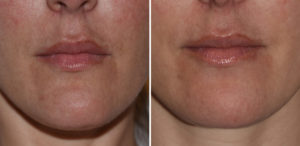Chin reduction is a form of chin reshaping surgery that involves changing the size and possibly the shape of the chin in order to make it appear smaller. This surgery may be beneficial to those who have a large chin that looks disproportionate when compared to the rest of the face. A chin may look too large in two dimensions, either being too long vertically or projecting too far forward horizontally. In rare cases, both dimensions of chin enlargement may be enlarged but usually it is one or the other.

Excessive horizontal chin excess is done through a burring down and tissue resuspension technique. Through an incision underneath the chin, the bone is exposed and the desired amount of excess bone removed. Because the attached soft tissues have had to be stripped off of the bone, they must be reattached or sagging (witches chin deformity) will occur afterward. Excess muscle and skin are removed and sutures are used to reattach them tightly to the bone.
All chin reduction methods require careful attention to how the bone is taken down and whether the soft tissues remained attached to the bone. Simple ‘sanding down’ a prominent chin, as has been done by many in the past, will only lead to secondary chin problems.
Frontal and profile photographic analysis should be done before surgery to determine how much bone reduction is needed. Since there is a pretty good linear relationship between bone changes in the chin and changes seen externally, photographic analysis is useful in all types of chin surgery.
Dr. Barry Eppley
Indianapolis, Indiana


